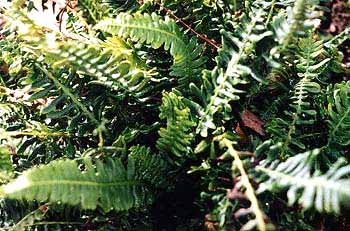 The Endearing
The Endearing
& Enduring
Deer Fern
"All these fairy dreams of greenwood fern,
These waves that break & yearn."
-Alfred Noyes
1880-1958
1880-1958
This tufted Deer Fern (Blechnum spicant) lives in the shade of our paperbark maple. It's an evergreen with a pleasing year-round appearance, having a tidy compact growth.
Of all the Northwest native ferns that are so very gardenable, the two most resplendant for temperate gardens are the small to medium-sized deer ferns, & the humongous sword fern; both are ideal &am,p ultra-hardy garden ferns for moderate to deep shade.
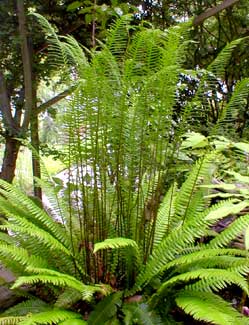 The first portrait was taken in March (2002) before it begins putting on new spring growth, yet it looks very little worse for wear having lasted through the winter.
The first portrait was taken in March (2002) before it begins putting on new spring growth, yet it looks very little worse for wear having lasted through the winter.The second photo is from May (2004), showing many of the upright fertile leaves. It doesn't produce quite so many of the fertile leaves in every year, but they were particularly plentiful for this year.
The third photo is from September (2003), showing also the "umbrella" of leaves belonging to a Taiwanese jack-in-the-pulpit. That year it did not produce as many of the sterile upright fronds.
Though I'd judge this fern fully & even radically evergreen because of a stunning presence even at the height of winter, in reality, to some extent, it is merely semi-evergreen, because only the sterile leaves that reproduce exclusively from rhizomes never die back. Hence the evergreen portion of the fern tends to be that portion which either fountains or hugs the ground.
The older the plant gets the more of these ground-hugging sterile leaves it will have, but younger (but mature0 plants may have a larger percentage of upright fertile leaves which don't have quite the year-round presence. When the upright fronds dry out in winter, still hovering above fully green prostrate leaves, they look sufficiently flower-like to be of added interest if left untrimmed.
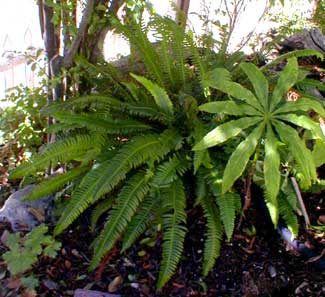 Even these spoor-producing upright leaves sometimes remain green through half or two-thirds of the winter, but they'll be brown & dead by winter's end or early in spring & will need trimming out in spring. They will have spoored late in the previous summer, & they only spoor that one time, so the upright fronds have served their primary purpose. This is why specimens with a lot of height can get scruffy at the top, when the fronds that reproduced spoors are dying, whereas specimens that remain shortest have fewer fertile leaves hence have less late-winter or early-spring die-back.
Even these spoor-producing upright leaves sometimes remain green through half or two-thirds of the winter, but they'll be brown & dead by winter's end or early in spring & will need trimming out in spring. They will have spoored late in the previous summer, & they only spoor that one time, so the upright fronds have served their primary purpose. This is why specimens with a lot of height can get scruffy at the top, when the fronds that reproduced spoors are dying, whereas specimens that remain shortest have fewer fertile leaves hence have less late-winter or early-spring die-back.Then again, the spoor-producing fronds if not too tattery from browsings of deer or harsh weather can themselves be very pretty & almost flower-like. The fourth photo below, snapped in early January (2005), shows the spent fertile fronds in their brown glory, sharply contrasting with the perpetually bright green sterile fronds.
I've never been able to figure out if the ones with the fewest upright dieback leaves result from hereditary or environmental factor, but I suspect it is a combination of heredity & environment. At least it seems to me that if you select deer ferns in winter to get the fewest fertile leaves, it will in most years remain more fully evergreen, though once in every three or four years any specimen is apt to decide it wants to produce a good large crop of the transient upright spooring leaves. Conversely if you select one in winter for maximum upright browning leaves, it'll continue to produce lots of these more years than not.
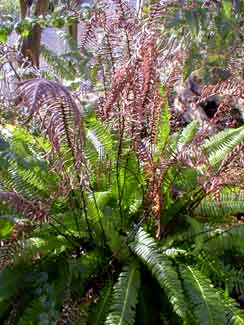 It is the same specimen shown in the first four photos. I obtained additional specimens near Hoquiam on the edge of the rainforest, & these now grow under a fir tree in a friend's garden I helped landscape. They transplant easily & without complaint, especially in autumn, but can be unsightly their first winter because large wild specimens have never been dressed & will have lots of dead bits. Any blackened fronds have to be trimmed out of the clump, & it will totally repair itself the following spring. With minimal dressing thereafter (trimming for appearance once a year or less) it will never thereafter have even slight scruffiness, but will always be a year-round beauty.
It is the same specimen shown in the first four photos. I obtained additional specimens near Hoquiam on the edge of the rainforest, & these now grow under a fir tree in a friend's garden I helped landscape. They transplant easily & without complaint, especially in autumn, but can be unsightly their first winter because large wild specimens have never been dressed & will have lots of dead bits. Any blackened fronds have to be trimmed out of the clump, & it will totally repair itself the following spring. With minimal dressing thereafter (trimming for appearance once a year or less) it will never thereafter have even slight scruffiness, but will always be a year-round beauty.The fifth photo is a baby deer fern that erupted on its own in a moist humusy location in quite a bit of sunlight. I transplanted it into the shade garden & immediately snapped its portrait in October (2005). It will be fun to watch it slowly develop into a big clump as did the one under the paperbark maple.
Deer ferns suffer very little in summer, just as they suffer very little in winter. So long as it is kept moist & shady it will remain a dramatic little fern in all seasons. I've seen very tatty specimens in summers, but they weren't well cared for or were in too much sun. Though drought won't kill them, they should be kept moist at the height of summer in order to always look their best.
It gets the name Deer Fern because it provides winter forage for deer, elk, caribou, moose & bighorn sheep from the Columbia River to Alaska. It is an interesting evolutionary feature that the permanently green portion of the fern lays flat so that this part of the fern is less apt to be eaten in the wintertime (when in much of its range it'll be under snow), whereas the upright fronds that are much more inevitably munched on in the wilderness will have already reproduced by late summer or early fall & would be dying back at the end of winter in any case, so it's almost like those leaves last the extra months through winter specifically to feed the deer. Nature works so gosh darned well!
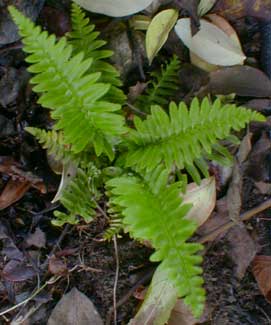 It spreads by creeping rhizomes & will eventually reach two feet width, often remaining under a foot tall though in ideal conditions capable of reaching two feet height. It is also easily grown from spoors, which can be sewn in late summer.
It spreads by creeping rhizomes & will eventually reach two feet width, often remaining under a foot tall though in ideal conditions capable of reaching two feet height. It is also easily grown from spoors, which can be sewn in late summer.If it outgrows a location the spreading clumps can be divided in spring, or else permitted to become a groundcover. It needs little or no care, requiring no fertilizing since it does best in nitrogen-poor soil, preferring to be fed only natural leaf mold & decayed needles or wood shavings.
In England it is called the Hard Fern because of its rugged texture. Though it is rather extreme in its cold-hardiness, distributed well into southeast Alaska, nevertheless, in colder zones, it can be temporarily damaged by frost. But here on temperate Puget Sound, it barely needs any trimming even in early spring, when most other evergreen ferns would need considerable dressing.
It is unevenly distributed all around the northern hemisphere, but as a North American native fern it is most common west of the Cascade & Sierra Mountain ranges reaching as far south as Santa Cruz. It is found primarily but not exclusively in the shade of large evergreens such as Douglas fir, hemlock, redwoods, or the Sitka spruce, from subalpine mountain forests to sea level.
It is very common along the British Columbia coast & in Washington & Oregon but as one goes inland it becomes uncommon.
The Kwakiutl Indians of British Columbia regarded the roots of deer ferns as medicinal, & the leaves were used with bandages to cover small wounds. Native American folklore explains that they learned deer fern could relieve pain by topical application from having observed elk, moose, or deer which had recently shed their antlers rubbing the sensitive area of their heads on deer fern clumps. Additionally, the rhizomes were regarded as an emergency food item.